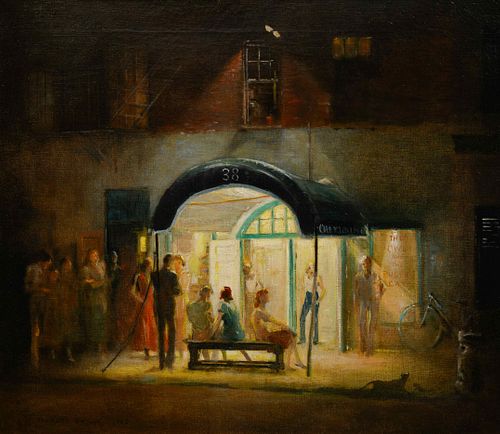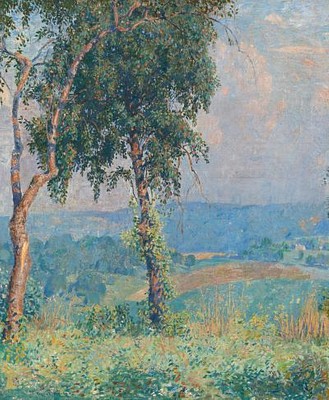Everett Shinn(American, 1876-1953)Cherry Lane Theater, 1948
Lot 33
About Seller
Hindman
1338 West Lake Street
Chicago, IL 60607
United States
Recognized as the Midwest's leading fine art auctioneers, Hindman Auctioneers has built a worldwide reputation based on a full service approach to the auction business tailored to meet the individual needs of our clients. Coming from a variety of educational backgrounds, specialists bring years of e...Read more
Estimate:
$50,000 - $70,000
Absentee vs Live bid
Two ways to bid:
- Leave a max absentee bid and the platform will bid on your behalf up to your maximum bid during the live auction.
- Bid live during the auction and your bids will be submitted real-time to the auctioneer.
Bid Increments
| Price | Bid Increment |
|---|---|
| $0 | $25 |
| $500 | $50 |
| $1,000 | $100 |
| $2,000 | $250 |
| $5,000 | $500 |
| $10,000 | $1,000 |
| $20,000 | $2,500 |
| $50,000 | $5,000 |
| $100,000 | $10,000 |
About Auction
By Hindman
May 3, 2021
Set Reminder
2021-05-03 11:00:00
2021-05-03 11:00:00
America/New_York
Bidsquare
Bidsquare : American & European Art
https://www.bidsquare.com/auctions/hindman-auctions/american-european-art-6794
Hindman Bidsquare@hindmanauctions.com
Hindman Bidsquare@hindmanauctions.com
- Lot Description
Everett Shinn
(American, 1876-1953)
Cherry Lane Theater, 1948
oil on canvas
signed Everett Shinn and dated (lower left)
19 x 22 inches.
Provenance:
Kraushaar Galleries, New York
Private Collection, Philadelphia, Pennsylvania, 1961
By descent through the family
Sold: Christie's, New York, May 21, 2003, Lot 69
David Findlay Jr., Inc, New York
Acquired directly from the above by the present owners
Property from the Collection of Noel and Kathryn Dickinson Wadsworth, Atlanta, Georgia
Lot essay:
Cherry Lane Theater, with its welcoming glow and crowd of people, documents a slice of New York theater life in the late 1940s. Still in existence in Greenwich Village, the Cherry Lane Theatre has long been a home for nontraditional and experimental works. Originally the site of a silo on the Gomez farm in 1817, the building that now stands at 38 Commerce Street was first erected as a brewery in 1836 and later served as a tobacco warehouse and box factory. In 1923, theater artists Evelyn Vaughn, William S. Rainey, Reginald Travers, and Edna St. Vincent Millay converted the structure into a theater they named the Cherry Lane Playhouse. The famed scenic designer and architect Cleon Throckmorton was commissioned to do the alterations. The theater fueled some of the most ground-breaking experiments of the American stage, including the Downtown Theater movement, The Living Theatre, and Theatre of the Absurd, which all took root at the Playhouse.
Interest and involvement in theatrical activities permeated the life of Everett Shinn from his youth when his obsession with the circus led him to learn acrobatics and he later honed his illustration skills by creating poster for the local opera house. As a maturing artist, Shinn became a member of “The Eight,” with Robert Henri as mentor and proponent of the true representation of gritty, urban life. A trip to Europe in 1900 exposed the young artist to the dynamic and vibrant work of Édouard Manet and Edgar Degas, which further fueled his interest in the depiction of the theater. Shinn’s devotion to performance was not limited to his painting practice. He wrote plays that he produced in his New York home on Irving Place; served as an art director in Hollywood; produced public murals; and worked as an illustrator and interior designer.
The present artwork reveals Shinn’s facility as both an illustrator and creator of tightly composed scenes. Viewed from across the street, the milling crowd outside the theater is sketchily but deftly described. A solitary woman sits and smokes next to a couple on a bench; a man in tuxedo and woman wearing an evening gown converse; a crowd of curious onlookers wait outside the shadows. The warm lights from the building spill out onto the sidewalk and envelopes the figures nearest in a convivial glow. The scene perhaps depicts intermission, capturing both the anticipation and tedium of the break in action. Unnoticed by the theatergoers, the dark shadow of a cat darts to the right but appears to look at the crowd as it runs by. Here, Shinn portrays the audience in the painting as actors themselves in an unknown play, for which the outside viewer can imagine the dramas and comedies within.For condition inquiries please contact marygracebilby@hindmanauctions.comCondition
- Shipping Info
-
Please refer to https://hindmanauctions.com/shipping-packing
-
- Buyer's Premium



 EUR
EUR CAD
CAD AUD
AUD GBP
GBP MXN
MXN HKD
HKD CNY
CNY MYR
MYR SEK
SEK SGD
SGD CHF
CHF THB
THB














